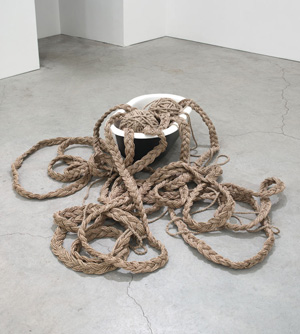6.14.24 — Bob and Weave
There are moments in “Weaving Abstraction” at the Met that feel suspended between centuries. Does MoMA seek the origins of modernity in the aftermath of World War II for “Crafting Modernity” This exhibition reaches back to antiquity. Yet it ends in much the same years and much the same artistic circles.
Are they telling the same story after all? The Met’s mere handful of recent artists can hardly encapsulate weaving or abstraction. Their pairing with art of the Andes has its own suspense nonetheless, through June 16. 
The exhibition’s full title speaks of “ancient and modern.” Centered on the Andes from as much as twenty-seven hundred years ago, it unfolds in space otherwise dedicated to modern and contemporary art. About halfway through, a panel could almost be a direct response to Minimalism. Its thousands of feathers affixed to cotton strings form a thick, soft surface that divides neatly into four rectangles, alternating between light yellow and blue. More yellow flecks the blue, as if about to take flight. Like the Post-Minimalism of Eva Hesse, it might be an extension of an animal or human body—or the human imagination.
The show features four women who came to prominence in just the last century, and they may feel suspended not just in time, but also in place. Anni Albers took up fabric at the Bauhaus but fled to America in 1933 and worked for sixty more years in exile. Sheila Hicks studied with her husband, Josef Albers, at Yale. Lenore Tawney studied with another refugee from the Bauhaus before joining the “fabric art” movement along with Olga de Amaral. What seems at first like a sprinkling of recent art, for contrast and relevance, gathers momentum over the course of a long room. By the show’s end, it has come to the very brink of the present.
It may seem like a mere excuse to approach either the present or the past—a routine excuse at that. More and more, museums are insisting on other times and other cultures, like Cycladic art at the Met. The museum has been slipping contemporary art into older contexts as well, like Korean art. More and more, too, artists have been turning to tapestries and fabric as their means of painting. It can serve as a further call for diversity, as well, to recognize “women’s work.” And now the Met heads to not just the rural South, but to the arid hills of South America.
But is there truly, as the Met puts it, an “Andean legacy”? The Bauhaus had its mission to promote craft as art, as a model for design. Albers did visit an ethnological museum back in Berlin. Yet her austere patterns have more to do with Modernism than ancient checkerboards. Hicks does not so much as take up weaving, although her dyes have parallels in ancient art. Her loose strands or the slits in Tawney’s slim black hangings, almost like gowns, may recall ancient “open looms.”
Peru is harder still to pin down, and the curators, Iria Candela and Joanne Pillsbury, make no attempt at chronology. They open with rich color from perhaps the 1500s, in a tunic of red and gray, before doubling back a millennium before to a coiled headband—and then further back to mystery figures from before the present era, their slim black tongues sticking out from sharp teeth beneath wild eyes. No wonder historians cannot assign many works to a single century, not when the culture left no written records. One cannot know when clothing served for necessity, for kings, for votive offerings, for gifts to secure peace, or for exchange. One cannot know either whether women produced a single one. One can know the lack of the very idea of abstraction.
Still, the Met is on a mission, too—to introduce the ancient and Incan cultures that the Spanish killed off. It is also insisting on women artists. de Amaral broadens fabric beyond what the Andes ever knew, with gold leaf, paper, and gesso on a “gridded wall.” Hicks is lushest and most varied of all, from densely curving colors to bare white descending in tassels as her Linen Lean-To. Its cryptic patterns may suggest an unknown language. But then the knots in ancient khipus may have communicated something, too.
Read more, now in a feature-length article on this site.